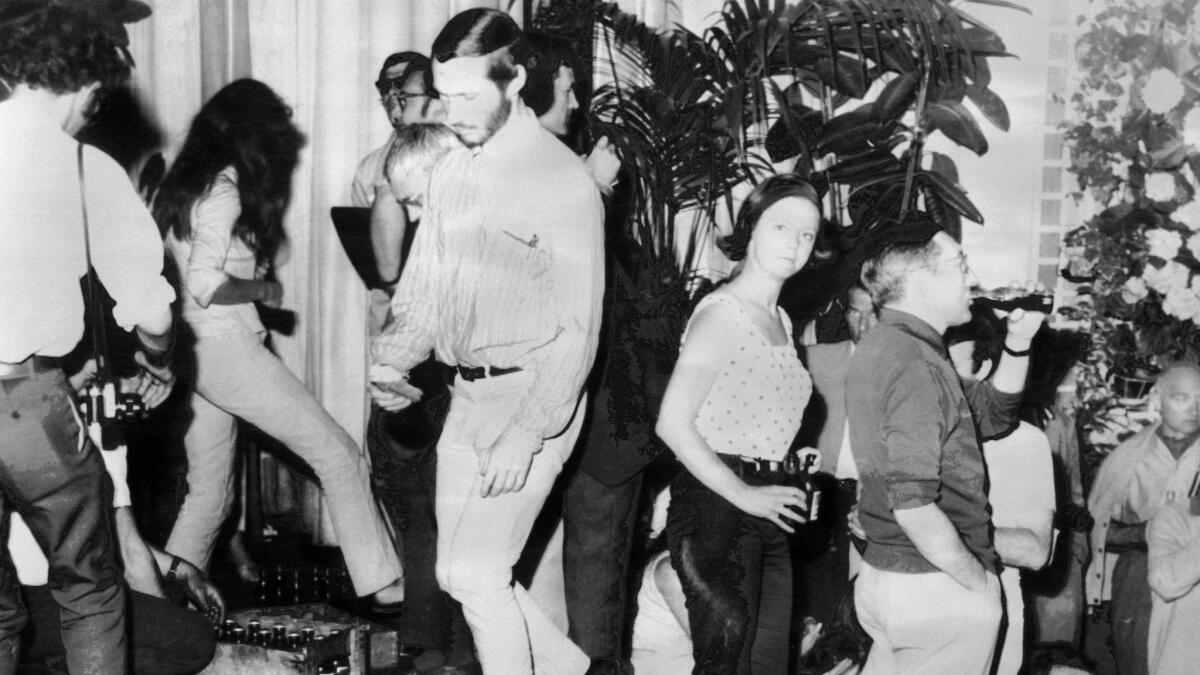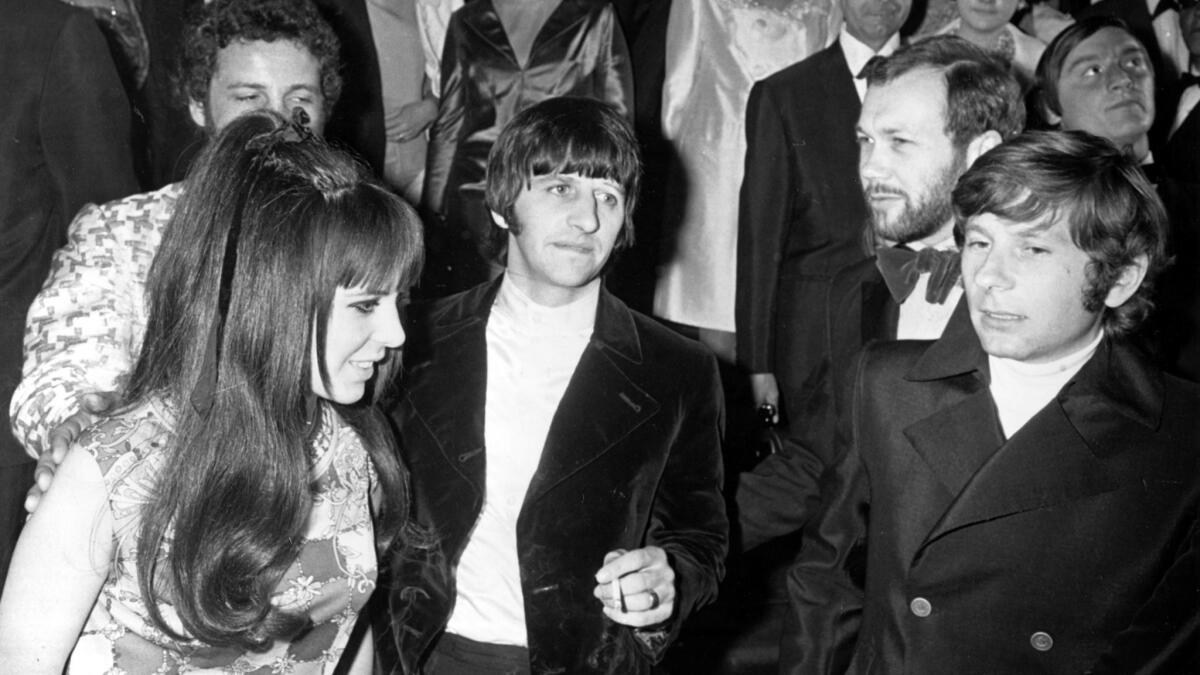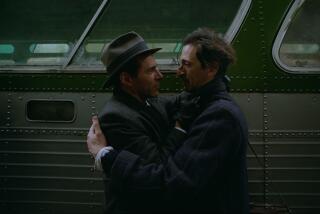In May 1968, the Cannes Film Festival ground to a halt. Fifty years later, it’s still sparking controversy
- Share via
In the newly released comedy “Godard Mon Amour,” Michel Hazanavicius’ playful flashback to France in the fateful year of 1968, a young Jean-Luc Godard (played by Louis Garrel) marches with an enormous crowd in Paris. Alongside him is the critic and filmmaker Michel Cournot, whose “Les Gauloises Bleues” is set to screen that May at the Cannes Film Festival.
“Who cares about Cannes?” a Godard acquaintance yells, bursting into derisive laughter. “Only a fool would go this year, with all that’s going on now!”
A lot was going on indeed. Millions of workers were on strike and students were pouring into the streets, all in opposition to President Charles de Gaulle’s government. On the film side, directors like Godard were furious that the culture minister André Malraux had fired Henri Langlois, the revered founder of the Cinémathèque Française — a decision that was ultimately reversed after filmmakers from Paris to Hollywood rose up in protest.
That revolutionary fervor soon encroached upon the small Riviera town of Cannes itself. The film festival opened as planned on May 10, 1968, with a screening of a restored version of “Gone With the Wind.” Nine days later, Godard and other directors, including François Truffaut and Claude Lelouch, led a group of cine-revolutionaries bent on shutting down the proceedings. They succeeded, in the process committing a strange, volatile, endlessly mythologized episode to the annals of Cannes history.
Directors withdrew their movies. (Canceled titles included Alain Resnais’ “Je T’Aime, Je T’Aime,” Dominique Delouche’s “24 Hours in the Life of a Woman” and Peter Collinson’s “The Long Day’s Dying.”) Members of the competition jury resigned, including Roman Polanski, Monica Vitti and Louis Malle. In the most memorably chaotic episode, protesters took the stage at an afternoon screening of Carlos Saura’s competition entry, “Peppermint Frappé,” an act that climaxed with the spectacle of Godard, Truffaut, Saura and his star Geraldine Chaplin hanging from the theater curtains.
Those who led the Cannes ’68 shutdown were effectively calling on the French film industry to express support for the demonstrators. But as with every revolution, not everyone was on the same philosophical page. Truffaut called for a complete halt to the festival; Godard initially proposed an overhaul that would do away with awards and replace programmed films with documentary footage from the ongoing events.

READ MORE: A look back at entertainment in 1968 »
Polanski revealed in a 2008 Variety interview that he had found the idea of stopping the festival “totally ridiculous,” and claimed he’d been forced to quit the jury against his will.
“I came from Communist Poland,” he said, “and I knew moments of elation like this where suddenly you just feel like you’re doing something great, when in fact it’s just an illusion.”
The irony, if that’s the word, is that the upheaval of May 1968 intersected with a profound, ongoing revolution in cinema itself. Throughout the late 1950s and ’60s, Godard and his fellow New Wave filmmakers had taken radically innovative steps: From Godard’s “Breathless” to Truffaut’s “The 400 Blows” to Alain Resnais’ “Hiroshima Mon Amour,” here was a vital, modern cinema that rejected the staid, well-behaved “tradition of quality” that had largely prevailed for the first half-century of the medium’s existence.
Here was art that, in its dazzlingly unorthodox approach to form and aesthetics, could mimic and even embody the exigencies of real life. The shutdown of Cannes ’68 sent a different though perhaps not contradictory message: Real life must, in the end, trump art.
“I’m talking about solidarity with the students and workers, and you’re talking about tracking shots and close-ups!” Godard famously spat at someone who opposed closing the festival. To put it another way: At a time like this, how could anyone sit around watching movies?
Even when the show doesn’t go on, there will always be another show. From the ashes of the aborted 1968 Cannes Film Festival there rose significant shifts in the direction of the festival, pushing it closer to the programming model that more or less exists today.

READ MORE: In 1968, moviegoers had a lot more choices before blockbuster fever took over »
For the festival’s first few decades (it launched in 1946), programmers largely selected movies approved and submitted by national film organizations. In 1969, however, a group of French filmmakers formed the Société des Réalisateurs de Films (or Film Directors’ Society). Galvanized by the events of 1968, these directors proposed sweeping reforms to the Cannes selection process.
When those proposals were rejected, the Society formed the Quinzaine des Réalisateurs, also known as the Directors’ Fortnight, a parallel festival held every year alongside Cannes — an edgy, independent, principled alternative to what has become known as the official selection.
And so the 1969 Cannes official competition screened such titles as Éric Rohmer’s “My Night at Maud’s,” Ronald Neame’s “The Prime of Miss Jean Brodie,” Dennis Hopper’s “Easy Rider” and Lindsay Anderson’s “If … ” (the eventual winner of the top prize). Meanwhile, not far from the Palais, the inaugural Directors’ Fortnight unveiled a robust 68-feature program that included Robert Bresson’s “A Gentle Woman,” Bob Rafelson’s “Head,” Bernardo Bertolucci’s “Partner,” Roger Corman’s “The Trip” and Nagisa Oshima’s “Diary of a Shinjuku Thief.”
Over the decades, as the official selection shifted away from its country-based system to a more auteur-driven lineup, the once-stark differences between the two programs began to blur. These days, the Fortnight no longer has a monopoly on edgy programming in Cannes, and the two festivals have developed a relationship that could be described as both symbiotic and adversarial.
The Fortnight laid claim to early works by Atom Egoyan (“Speaking Parts”), Michael Haneke (“The Seventh Continent”), Hou Hsiao-hsien (“Daughter of the Nile”) and Bong Joon-ho “(The Host”), all of who have gone on to become official selection regulars. For years, too, the Fortnight served as a hot launchpad for American independent directors like John Sayles, Whit Stillman and Spike Lee, who screened his debut feature, “She’s Gotta Have It,” there in 1986. Lee has been back to Cannes several times since, and returns to the main competition this year with a new drama, “BlacKkKlansman.”
Five decades after May 1968, more than a few are still asking the question posed in “Godard Mon Amour”: Who cares about Cannes?
As it happens, that wink-wink scene was edited into a promotional teaser for Hazanavicius’ movie shortly before its 2017 premiere at Cannes. It was a self-consciously cheeky dig at the anxiety surrounding that year’s festival, which implemented unprecedented security measures in response to renewed fears of terrorist activity in Europe. (The July 2016 Bastille Day attack in Nice, just 20 miles up the coast from Cannes, hit especially close to home.)
Curiously enough, “Godard Mon Amour” (or as it was known then, “Le Redoubtable”) was the subject of a false alarm at last year’s festival. I happened to be in line for the film’s first press screening when security guards suddenly ordered everyone in the building to evacuate, following the discovery of a suspicious-looking package inside the theater.
My colleagues and I waited a short distance from the Palais, and after about an hour were allowed back inside. The package, it turned out, was merely a bag someone accidentally left behind. Aside from that harrowing bit of farce, Cannes 2017 went off without a hitch. A year later, however, those beefed-up security measures will likely remain in place.
Still, to judge by recent headlines, the possibility of a terrorist attack seems to have been momentarily elbowed aside by less life-or-death considerations. Earlier this month, Thierry Frémaux, the festival’s general delegate, announced that attendees were not allowed to take selfies on the red carpet — a “grotesque” practice he was banning in the interests of restoring “a bit of decency.”
What Cannes considers decency, of course, has been dismissed in recent years as antiquated and sexist. The 2015 festival witnessed the embarrassing “Flatgate” controversy, in which numerous women reported having been turned away from gala screenings for not wearing appropriate high-heeled footwear.
READ MORE: The 10 best movies of 1968, according to the film critic who reviewed them all »
Over the years, criticism of the festival’s treatment of women has extended beyond the red carpet and into the selection process itself, specifically how few female directors are chosen for the competition — a problem that will surely continue to receive scrutiny in the wake of the #MeToo and #TimesUp movements. Notably, 2018 will mark the first Cannes post-Harvey Weinstein, who for years was one of the festival’s prime movers and shakers, and who stands accused of numerous acts of sexual assault and harassment, some allegedly at the festival itself. He has denied all allegations of nonconsensual sex.
But the most vocal Cannes 2018 debate so far has swirled around l’affaire Netflix. Last year, the streaming giant presented two titles (Bong Joon-ho’s “Okja” and Noah Baumbach’s “The Meyerowitz Stories”) in the main competition, to the outrage of French exhibitors. This year, Frémaux announced that, going forward, only films with French theatrical distribution would be allowed to compete, a rule that effectively disqualified the theater-averse Netflix.
Stung, Netflix announced just last week that it would bypass the festival altogether, denying Frémaux two films, Alfonso Cuarón’s “Roma” and the newly completed Orson Welles project “The Other Side of the Wind,” that he had wanted to program.
The Cannes-Netflix feud may be a classic media teapot tempest, but it also spurred industry observers to ask: Is Cannes showing its age and irrelevance, or taking a principled stand? Is it a festival stuck in its own rich but imperfect history, or the last defender of the theatrical moviegoing experience in an industry that’s resigned itself to serving smaller screens and lazier appetites?
Only time will provide the answers. But even as the 71st annual Festival de Cannes unfolds, against a backdrop of geopolitical turmoil, gender-parity course correction and brand-new (but really age-old) debates over art versus commerce, I must say I’m looking forward to this year’s lineup, which suggests that, if nothing else, Cannes hasn’t lost its talent for reinventing itself.
There are fewer old-guard auteurs than usual and many promising new names in competition, including Lebanon’s Nadine Labaki, Japan’s Ryûsuke Hamaguchi and one director, Iran’s Jafar Panahi, who belongs on any shortlist of the world’s greatest filmmakers. Another person on that shortlist is — who else? — Jean-Luc Godard, who will appear in competition for the eighth time with a new movie, “The Image Book.”
Godard hasn’t attended the festival in years, and at 87, he is likely in no state to find himself hanging from the curtains this time around. But even if he doesn’t bring Cannes to a screeching halt, I imagine he’ll have no trouble bringing it to its feet.
More on the cultural shifts of 1968:
Days of rage and wonder: Full coverage of 1968’s cultural changes
How filmmaking, romance and the politics of 1968 collide in Michel Hazanavicius’s ‘Godard Mon Amour’
East L.A., 1968: ‘Walkout!’ The day high school students helped ignite the Chicano power movement
‘The Mod Squad,’ ‘Adam-12’ and how TV brought the counterculture into 1968’s cop shows
California Sounds 1968: 10 essential Los Angeles-infused records from a kaleidoscopic era
1968: The year war came through the TV and I felt pieces of childhood ending
A 1968 timeline of anger, grief and change
Author Todd Gitlin on how to remember 1968
More to Read
Only good movies
Get the Indie Focus newsletter, Mark Olsen's weekly guide to the world of cinema.
You may occasionally receive promotional content from the Los Angeles Times.











